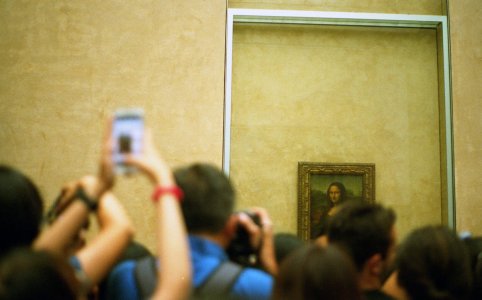The incredible theft that made the Mona Lisa a household name
By
Veronica E.
- Replies 0
Today, the Mona Lisa is the most famous painting in the world—but that wasn’t always the case.
In fact, it took a bold and shocking theft over a century ago to turn this Renaissance portrait into a global icon.
It all happened early on the morning of August 21, 1911, when a man dressed as a museum worker quietly entered the Louvre Museum in Paris.
The building was closed to the public at the time, so no one questioned him as he walked through the halls, into the Salon Carré, and up to a familiar portrait of a woman with a mysterious smile.
That woman was Mona Lisa, painted by Leonardo da Vinci.
The man, later identified as Vincenzo Peruggia, took the painting off the wall, carried it into a nearby stairwell, and removed it from its heavy wooden frame.
Then, with the artwork hidden under his white smock, he walked out of the building and disappeared into the streets of Paris.

Shockingly, it took almost 24 hours for anyone to notice the Mona Lisa was missing.
It was reportedly an artist, Louis Béroud, who first raised the alarm when he arrived at the gallery the next day and found an empty spot on the wall.
At first, staff assumed the painting had been taken down for routine photography.
But once it became clear it had been stolen, the museum went into panic mode.
Police combed the Louvre from top to bottom, and the story made front-page news across the world.
Even Pablo Picasso was briefly considered a suspect.
He was never involved in the theft—but at the time, he did happen to have two stolen sculptures from the Louvre in his possession.
For a week, the museum closed to the public.
When it finally reopened, people lined up not to see the art—but to stare at the blank space where the Mona Lisa used to hang.
Visitors even left flowers, treating the loss like a public mourning.
The man responsible wasn’t a notorious criminal or a famous artist—he was a little-known handyman who had once worked at the Louvre.
Vincenzo Peruggia, an Italian national, had helped install protective glass over several paintings, possibly including the Mona Lisa itself.
That experience gave him insider knowledge about the museum’s routines and security—or lack of it.
His exact motive is still debated.
Some believe Peruggia acted out of nationalist pride, hoping to return the painting to Italy, where it was originally created.
Others think he planned to sell it.
Whatever the reason, he kept the Mona Lisa hidden for two years inside a false-bottomed trunk in his modest Paris apartment.
In late 1913, Peruggia finally tried to sell the painting.
He contacted a respected art dealer in Florence and claimed he had a missing da Vinci masterpiece.
The dealer was suspicious—and quickly alerted the authorities.
Soon after, Peruggia was arrested and the Mona Lisa was recovered, unharmed.
He served just seven months in prison and later returned to France, where he lived until his death in 1925.
Before the theft, the Mona Lisa was considered a beautiful work of art—but it wasn’t the center of attention.
It was just one of many masterpieces hanging in the Louvre.
But the heist changed everything.
Suddenly, the image of the Mona Lisa was everywhere—in newspapers, on posters, in headlines around the world.
Millions of people who had never stepped foot in a museum now recognized her face.
When the painting was returned to the Louvre in early 1914, the crowd that gathered to see it was larger than ever.
As art historian Mary McGillivray put it, the theft didn’t just make the Mona Lisa more famous—it made her legendary.
Peruggia claimed he wanted to “return” the painting to Italy.
It’s a sentiment that echoes modern debates about who should own historic artwork, especially pieces taken during wars or colonial times.
Many masterpieces by Italian artists like da Vinci are displayed in museums outside of Italy, including the Louvre.
That continues to stir up questions about cultural heritage, art ownership, and national pride.
But in the end, the Mona Lisa returned to her home in Paris—where she remains today, behind bulletproof glass and under constant guard.
What makes this story so compelling—even today—isn’t just the daring theft or the mystery surrounding Peruggia’s motives.
It’s how a single act turned a Renaissance portrait into the most recognized artwork in the world.
In losing the Mona Lisa, the world saw her in a whole new light.
And in getting her back, we never stopped looking.
Read next: Tears and nostalgia: The heartwarming story of Simon & Garfunkel's unexpected reunion

What do you think? Did you know the Mona Lisa became famous because of a theft? Have you ever seen the painting in person, or do you remember hearing this story years ago? Share your thoughts in the comments—we’d love to hear your take on one of the world’s most surprising art stories!
In fact, it took a bold and shocking theft over a century ago to turn this Renaissance portrait into a global icon.
It all happened early on the morning of August 21, 1911, when a man dressed as a museum worker quietly entered the Louvre Museum in Paris.
The building was closed to the public at the time, so no one questioned him as he walked through the halls, into the Salon Carré, and up to a familiar portrait of a woman with a mysterious smile.
That woman was Mona Lisa, painted by Leonardo da Vinci.
The man, later identified as Vincenzo Peruggia, took the painting off the wall, carried it into a nearby stairwell, and removed it from its heavy wooden frame.
Then, with the artwork hidden under his white smock, he walked out of the building and disappeared into the streets of Paris.

Sometimes a single moment in history can change how the world sees a work of art forever. Image Source: Pexels / Jill Evans.
A missing masterpiece—and a stunned public
Shockingly, it took almost 24 hours for anyone to notice the Mona Lisa was missing.
It was reportedly an artist, Louis Béroud, who first raised the alarm when he arrived at the gallery the next day and found an empty spot on the wall.
At first, staff assumed the painting had been taken down for routine photography.
But once it became clear it had been stolen, the museum went into panic mode.
Police combed the Louvre from top to bottom, and the story made front-page news across the world.
Even Pablo Picasso was briefly considered a suspect.
He was never involved in the theft—but at the time, he did happen to have two stolen sculptures from the Louvre in his possession.
For a week, the museum closed to the public.
When it finally reopened, people lined up not to see the art—but to stare at the blank space where the Mona Lisa used to hang.
Visitors even left flowers, treating the loss like a public mourning.
Also read: This 160-year-old painting has an alleged time traveler–Expert decodes the mystery!
Who was the thief?
The man responsible wasn’t a notorious criminal or a famous artist—he was a little-known handyman who had once worked at the Louvre.
Vincenzo Peruggia, an Italian national, had helped install protective glass over several paintings, possibly including the Mona Lisa itself.
That experience gave him insider knowledge about the museum’s routines and security—or lack of it.
His exact motive is still debated.
Some believe Peruggia acted out of nationalist pride, hoping to return the painting to Italy, where it was originally created.
Others think he planned to sell it.
Whatever the reason, he kept the Mona Lisa hidden for two years inside a false-bottomed trunk in his modest Paris apartment.
Also read: Are you making these home repair mistakes that could be draining your wallet?
The return of the Mona Lisa
In late 1913, Peruggia finally tried to sell the painting.
He contacted a respected art dealer in Florence and claimed he had a missing da Vinci masterpiece.
The dealer was suspicious—and quickly alerted the authorities.
Soon after, Peruggia was arrested and the Mona Lisa was recovered, unharmed.
He served just seven months in prison and later returned to France, where he lived until his death in 1925.
From overlooked painting to international sensation
Before the theft, the Mona Lisa was considered a beautiful work of art—but it wasn’t the center of attention.
It was just one of many masterpieces hanging in the Louvre.
But the heist changed everything.
Suddenly, the image of the Mona Lisa was everywhere—in newspapers, on posters, in headlines around the world.
Millions of people who had never stepped foot in a museum now recognized her face.
When the painting was returned to the Louvre in early 1914, the crowd that gathered to see it was larger than ever.
As art historian Mary McGillivray put it, the theft didn’t just make the Mona Lisa more famous—it made her legendary.
Also read: The portrait controversy that shook an artist's world: Trump’s critique and its aftermath
Why the story still matters
Peruggia claimed he wanted to “return” the painting to Italy.
It’s a sentiment that echoes modern debates about who should own historic artwork, especially pieces taken during wars or colonial times.
Many masterpieces by Italian artists like da Vinci are displayed in museums outside of Italy, including the Louvre.
That continues to stir up questions about cultural heritage, art ownership, and national pride.
But in the end, the Mona Lisa returned to her home in Paris—where she remains today, behind bulletproof glass and under constant guard.
What makes this story so compelling—even today—isn’t just the daring theft or the mystery surrounding Peruggia’s motives.
It’s how a single act turned a Renaissance portrait into the most recognized artwork in the world.
In losing the Mona Lisa, the world saw her in a whole new light.
And in getting her back, we never stopped looking.
Read next: Tears and nostalgia: The heartwarming story of Simon & Garfunkel's unexpected reunion
Key Takeaways
- In 1911, Italian handyman Vincenzo Peruggia stole the Mona Lisa from the Louvre by disguising himself as a museum worker and walking out with the painting hidden under his smock.
- The theft wasn’t discovered for nearly 24 hours, causing international headlines and public shock; even Pablo Picasso was briefly considered a suspect.
- Peruggia kept the painting hidden in his Paris apartment for two years before trying to sell it to an art dealer in Florence, which led to his arrest.
- The heist turned the Mona Lisa into a global icon, with her image widely circulated during the search and her return drawing massive public attention.
- Peruggia claimed he stole the painting to return it to Italy, a motive that continues to echo modern debates about art ownership and cultural repatriation.
- The Mona Lisa was returned to the Louvre in January 1914, where she remains today—now one of the most recognized artworks in history.
What do you think? Did you know the Mona Lisa became famous because of a theft? Have you ever seen the painting in person, or do you remember hearing this story years ago? Share your thoughts in the comments—we’d love to hear your take on one of the world’s most surprising art stories!






